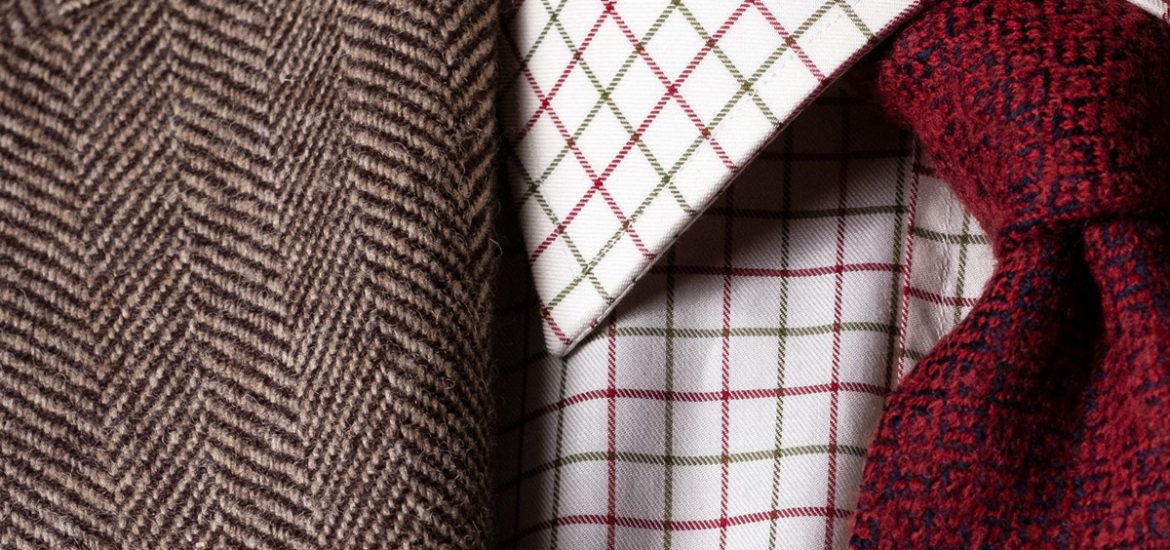Fabrics can generally be divided across three categories: conventional fabrics that are ideal for the most classic and versatile of suits; more sophisticated options infused with a more formal allure (often featuring pinstripes or Prince of Wales patterns); at the other end of the spectrum, sporting fabrics were created for outdoor activities.
While in Italy, and in Tuscany especially, velvet, an equally sturdy yet softer evolution of the once popular fustian, always was the preferred option, across the Channel tweed was the cloth of choice across the entire United Kingdom.
Menu
What is tweed?
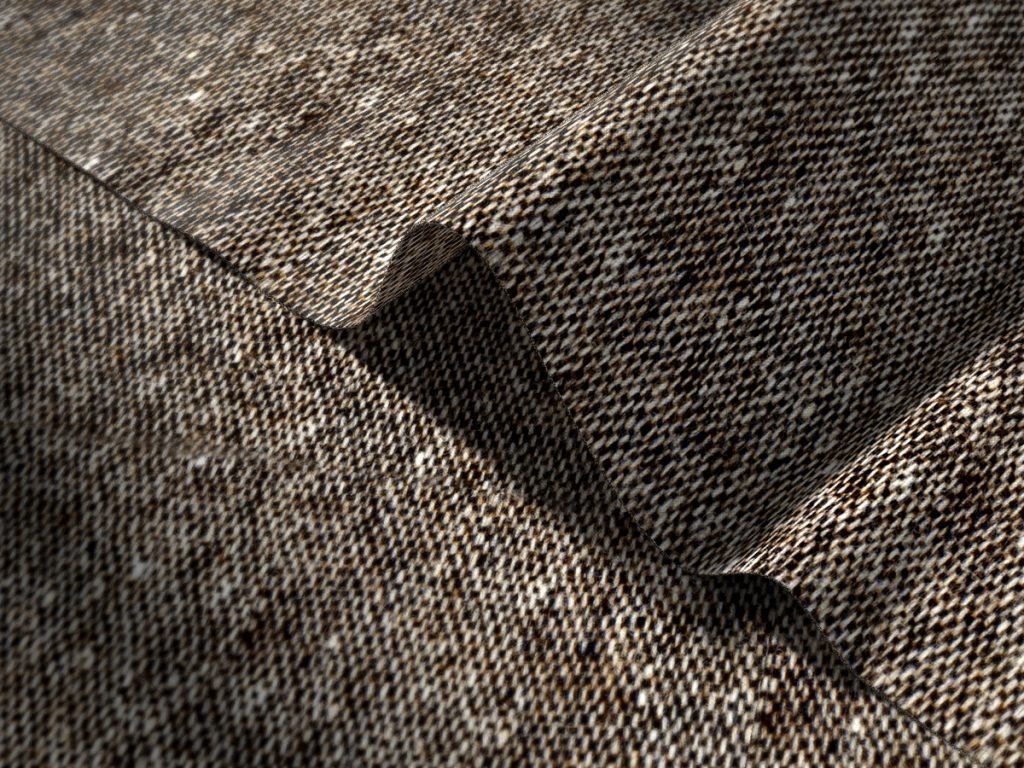
Tweed is a specific kind of fabric obtained from raw Shetland wool, giving it a soft and loose weave. Known for its heavy, sturdy and rough texture and high resistance to cold temperatures and bad weather conditions (rain and wind).
Tweed is often woven using different color yarns in order to create unique patterns, often featuring vertical stripes or checks. The colorful effect can also be achieved by mixing solid dyed wool prior to spinning.
Let’s start from the raw material: medium-heavy gauge wool that is perfect to produce the right yarn for heavy fabrics. The most common type of weave used for tweed is twill. Wool tweed is often woven using yarns in different colors to achieve colorful and dynamic fabrics, often adorned with small checks and vertical stripes.
For centuries, tweed was an essential component of British style, but its fame definitely travelled much beyond the great Albion; its unique features made it especially popular in neighboring countries such as Ireland, before eventually reaching continental Europe.
We need to keep in mind the way we used to live, in housing that didn’t come with central heating, which made warm, comfortable layers all the more necessary. Tweed was therefore very popular for suits and jackets, especially during activities such as archery or hunting.
History and origins
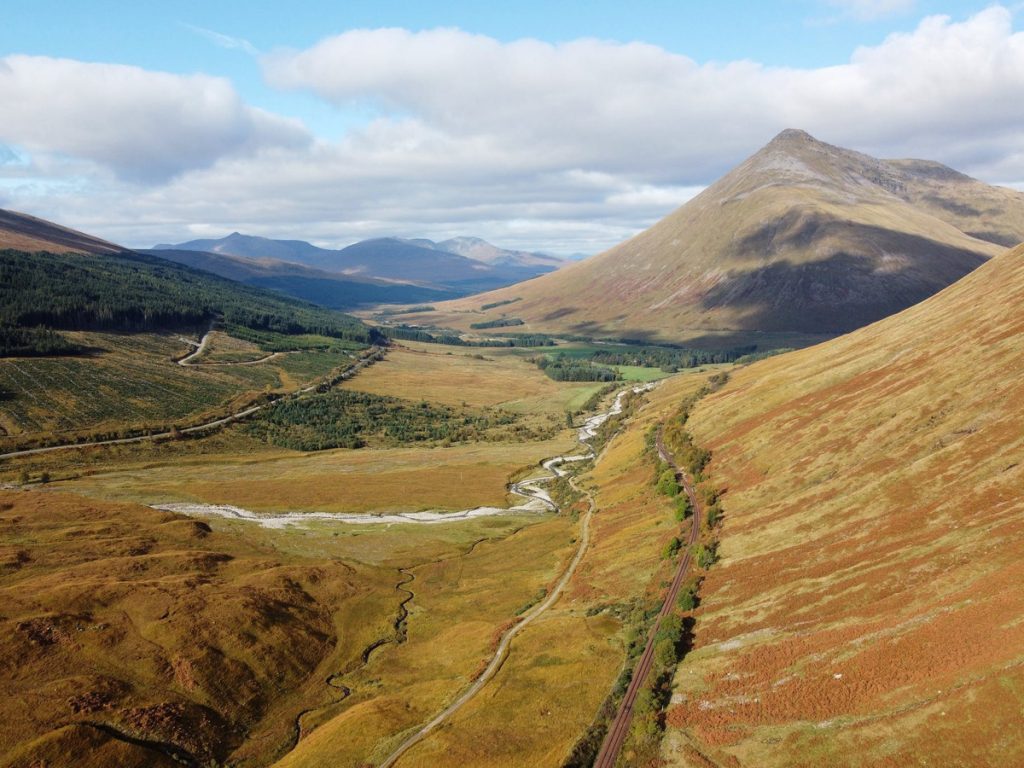
Tweed originates from Scotland, a country known for its challenging weather conditions, not to forget its distilleries, golf courses and, of course, James Bond. Tweed was initially known as “tweel”, as a nod to the way it was most often produced.
The name comes from the weave used in the textile plants found alongside the river Tweed in the 19th century, which also delineates the historic border between England and Scotland. This weave is the base used to create patterns such as diagonal stripes and fishbone, which can be combined in a number of ways.
It is believed that the name came about when an English merchant confused the word “tweel” for “tweed”, convinced as he was it was named after the famous Scottish river. The name instantly resonated with people and thus the name stuck.
From farmers to noblemen
Initially worn by Scottish and Irish farmers, it soon gained popularity amongst the upper class across the British Isles after Prince Albert bought Balmoral Castle in Scotland in 1848, which would soon become the birthplace of the famous Balmoral Tweed.
Blue with white specks, which from a distance resembles the local grey granite stone found in the surrounding mountains, this tweed provided ideal camouflage during hunting sessions. This is how one of the first estate tweeds was born.
From then on, every Scottish estate started creating their own kind of tweed with which to stand out during outdoor activities and hunting parties.
The gentlemen’s sporting fabric
From the early 20th century, tweed became the most technically advanced fabric, and the cloth of choice for gentlemen’s sporting activities. Its unique features allowed to hunt, shoot and fish while keeping warm and feeling comfortable.
Tweed also gained popularity amongst the British middle classes of the Victorian era in the mid-19th century, a symbol as it was of the leisurely ways of the upper class.
It was thus worn for sports and hobbies, be it driving, riding a motorcycle or bicycle, or even playing golf or tennis; it remained the fabric of choice on golf courts right until the summer of 1930, when the first flannel garments started taking over. In the past, tweed was the ultimate sporting and outdoor fabric, a perfect choice for the countryside that stood out from the dark suits worn in the city.
Tweed today
While it is often still associated with a number of stereotypes (college professor, East Coast intellectual or an old-school country gentleman) in our collective imagination, tweed has enjoyed a comeback over the past few years, partly thanks to its use in contemporary subcultures. Indie and hipster trends have brought it back as part of vintage-inspired looks.
This love of tweed is also still alive amongst vintage-loving sports enthusiasts. Held in central London, the Tweed Run is a bicycle race known and loved for its participants’ retro-style looks.
These new uses have helped keep the tweed tradition alive, while also infusing it with a new energy. Today still, a tweed jacket or suit is evocative of timeless sophistication.
Types and categories
There are different kinds of tweed, depending on the sheep the wool comes from, the area in which it is harvested, the weaving technique, the pattern, the use and the brand. Here are some of the main varieties of this warm and sturdy fabric:
Harris Tweed
Originating from the Hebrides, a Scottish archipelago off the northwestern coast of the mainland, Harris Tweed was produced from pure virgin wool, carded, woven and dyed (using natural vegetable dyes) by hand by locals in their own homes. Its distinctive features includes a fishbone pattern in a contrast palette, a wide range of colors and a coarser texture than regular tweed. In 1909, Harris Tweed became a registered trademark, easily identifiable via its globe logo.
Donegal Tweed
Also known as Irish Tweed, Donegal Tweed originates from the namesake county, in the village of Ardara, where the artisan tradition is still kept alive. Adorned with multicolored specks, this coarse cloth is one of the most popular tweeds.
Saxony tweed
Originating from Saxony (Germany), this type of tweed is woven using Merino sheep, giving it a soft and smooth quality.
Italian tweeds
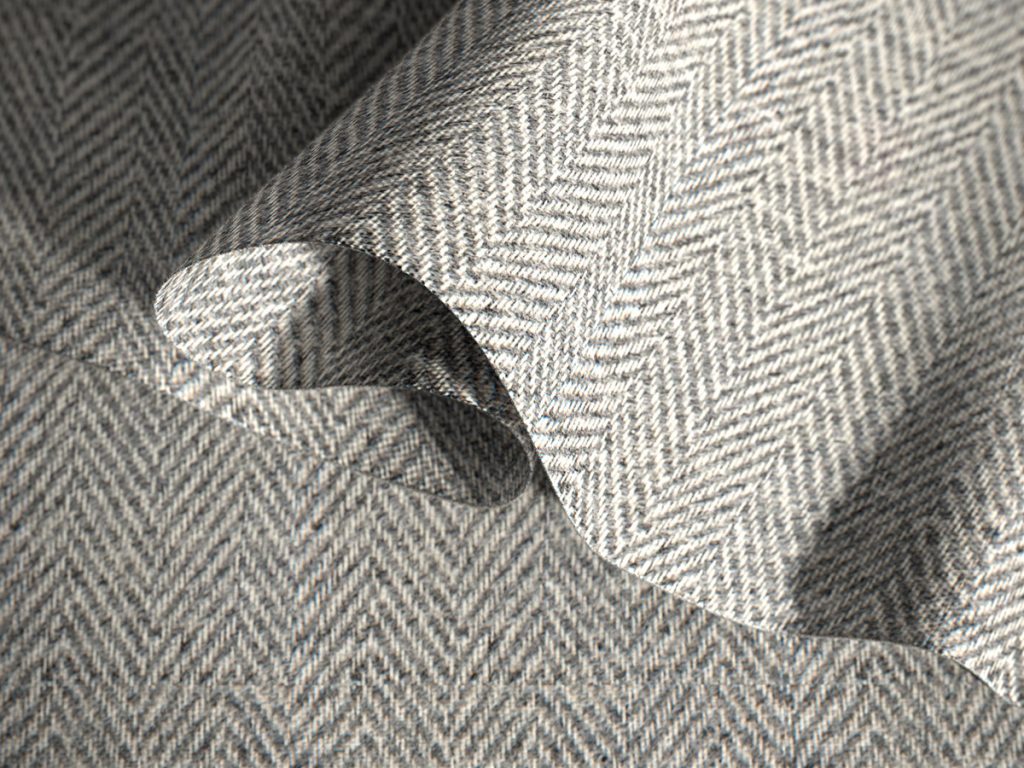
Italian tweeds are produced in the Biella region, birthplace of the Italian textile industry, by Lanificio Subalpino. This family-owned company uses Shetland wools to recreate typical patterns and colors associated with tweed.
Popular tweed patterns
Beyond the different kinds and textures we have just listed, tweed comes in many patterns. Some of the most popular designs are:
Plain tweed: a diagonal design across a plain weft
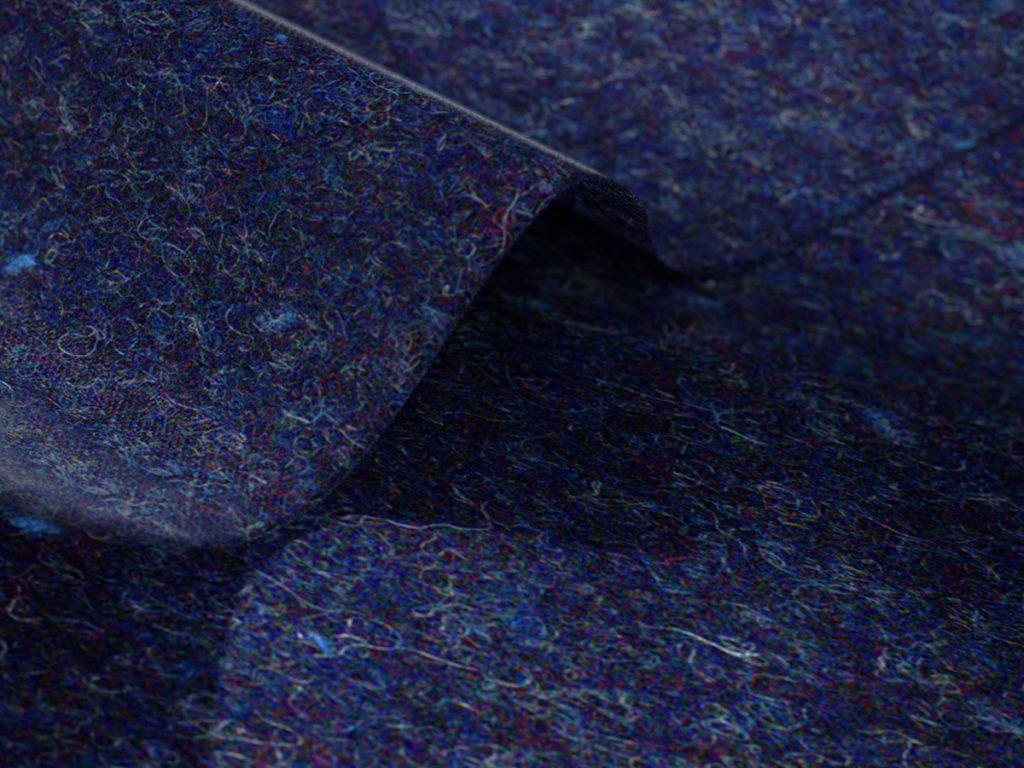
Overcheck tweed: overcheck pattern with contrast colors
Plain Herringbone: named for its resemblance with fishbones. It features an allover V motif that makes it especially easy on the eye
Overcheck Herringbone: also known as estate tweed, it features a colorful weave with a fishbone motif
Barleycorn tweed: this tweed stands out for its coarse and textured look
Striped: this type of tweed combines vertical and diagonal lines in different colors and sizes to achieve a bright and relaxed look.
Houndstooth: this pattern allowed to blend in during outdoor activities and was especially popular with hunting parties.
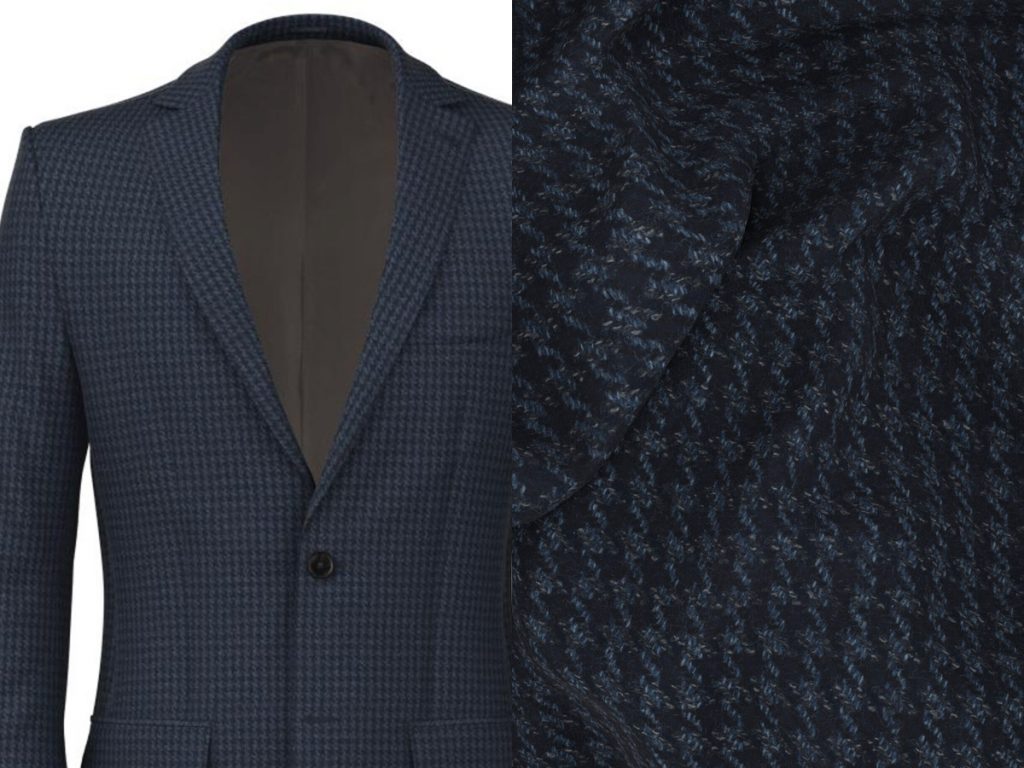
Check: vertical and horizontal lines create a classic check motif, which stands out thanks to different sizes and hues.
Tartan and plaids: the traditional Scottish pattern can also be woven as tweed.
When to wear it
Tweed is usually worn during the colder months, in the Fall-Winter season. But when is the best time to wear it? Ideally in informal and casual settings, in the countryside and the outdoors, on off-duty days or at the weekend.
In England, it is still used for hunting and fishing, as well as in the city or at the races. As a general rule, tweed can be worn in cold weather in any setting that allows for a casual suit or sports jacket.
How to wear it
Tweed can be worn from head-to-toe or as part of a mismatched look.
The suit
Tweed is ideally worn as a three-piece suit (jacket, waistcoat and pants). The jacket should always be single-breasted; a double-breasted tweed jacket is a definite style faux-pas. It should also feature three buttons. Due to its informal origins, notch lapels and central vents are essential in order to facilitate movement.
Tweed jackets and suggested combinations
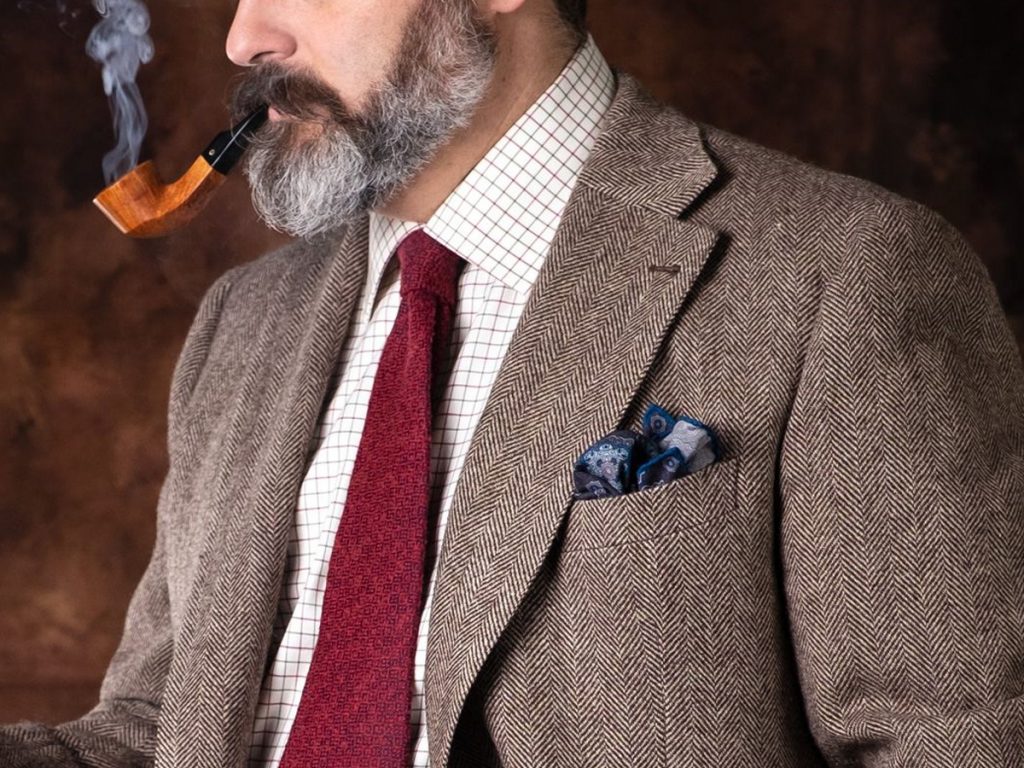
When purchasing a new tweed suit or jacket, you should always allow some time for the cloth to soften and adapt to the body. Once broken in, a tweed jacket offers superior comfort.
As a standalone garment, a tweed jacket allows for a number of informal combinations. Pants can be worn in wool or corduroy, In order to match the jacket’s weight.
Flannel also makes for an ideal combination, as do twill, fustian or waxed cotton. Lightweight tweed can be worn with chinos. For a more laidback look, classic denim can be a perfect companion for a tweed blazer.
If its pattern allows it, a tweed jacket can be a great match for a checked shirt. Most tweeds can be worn with non-white shirts. Try a pastel hue or a flannel shirt adorned with creative motifs. Turtlenecks are another option, although best worn in informal settings.
Accessories
When it comes to tie options, go for wool, whether knitted wool or cashmere, or potentially madder silk. Just like shirts, pocket squares shouldn’t be white.
When it comes to footwear, avoid classic lace-ups (especially in black) as they might come across as too formal. Brown brogues are ideal, as are ankle boots such as Jodhpurs and Chelsea boots, or double sole derbies.
Tweed accessories, such as hats or bags, are also especially popular thanks to their versatility and elegance. Flatcaps in particular, once worn by Highlands farmers and weavers, and later by rally drivers and golfers, are a modern-day favorite thanks to the extra touch of style they can add to any tweed suit or jacket.
Final considerations
A tweed jacket or suit is a sturdy and timeless garment that will add a refined allure to casual city looks and countryside outfits. Additional features such as slanted pockets, collar details or leather-covered buttons can provide further distinctive touches to make your suit comfortable, versatile and truly unique.

